Evolution Characteristics of Seismic Detection Probability in Underground Mines and Its Application for Assessing Seismic Risks—A Case Study
Abstract
:1. Introduction
2. Methodology
2.1. Probability of Detecting Earthquakes Method
2.2. Compensated Seismic Data
2.3. Detection Probability Similarity
3. Site Overview
3.1. Geological and Mining Conditions
3.2. Seismic Monitoring System and Seismic Hazards
4. Evolution of Detection Probabilities of the Seismic Monitoring System
4.1. Detection Capacity of Geophones (PD)
4.2. Detection Probability of the Seismic Monitoring System (PE)
5. Seismic Hazard Forecasting Using Compensated Seismic Data
6. Conclusions
Author Contributions
Funding
Institutional Review Board Statement
Informed Consent Statement
Data Availability Statement
Conflicts of Interest
References
- Zhang, C.; Canbulat, I.; Hebblewhite, B.; Ward, C.R. Assessing coal burst phenomena in mining and insights into directions for future research. Int. J. Coal Geol. 2017, 179, 28–44. [Google Scholar] [CrossRef]
- Cook, N. Seismicity associated with mining. Eng. Geol. 1976, 10, 99–122. [Google Scholar] [CrossRef]
- Iannacchione, A.T.; Tadolini, S.C. Occurrence, predication, and control of coal burst events in the US. Int. J. Min. Sci. Technol. 2016, 26, 39–46. [Google Scholar] [CrossRef]
- Patyńska, R.; Mirek, A.; Burtan, Z.; Pilecka, E. Rockburst of parameters causing mining disasters in Mines of Upper Silesian Coal Basin. E3S Web Conf. 2018, 36, 03005. [Google Scholar] [CrossRef] [Green Version]
- Jiang, Y.; Pan, Y.; Jiang, F.; Dou, L.; Ju, Y. State of the art review on mechanism and prevention of coal bumps in China. J. China Coal Soc. 2014, 39, 205–213. [Google Scholar]
- Gibowicz, S.J.; Kijko, A. An Introduction to Mining Seismology; Polish Academy of Sciences: Warsaw, Poland, 1994. [Google Scholar]
- Cao, A.; Dou, L.; Wang, C.; Yao, X.; Dong, J.; Gu, Y. Microseismic precursory characteristics of rock burst hazard in mining areas near a large residual coal pillar: A case study from Xuzhuang Coal Mine, Xuzhou, China. Rock Mech. Rock Eng. 2016, 49, 4407–4422. [Google Scholar] [CrossRef]
- Cai, W.; Dou, L.; Si, G.; Cao, A.; Gong, S.; Wang, G.; Yuan, S. A new seismic-based strain energy methodology for coal burst forecasting in underground coal mines. Int. J. Rock Mech. Min. Sci. 2019, 123, 104086. [Google Scholar] [CrossRef]
- Wang, G.; Gong, S.; Dou, L.; Wang, H.; Cai, W.; Cao, A. Rockburst characteristics in syncline regions and microseismic precursors based on energy density clouds. Tunn. Undergr. Space Technol. 2018, 81, 83–93. [Google Scholar] [CrossRef]
- Cai, W.; Bai, X.; Si, G.; Cao, W.; Gong, S.; Dou, L. A Monitoring Investigation into Rock Burst Mechanism Based on the Coupled Theory of Static and Dynamic Stresses. Rock Mech. Rock Eng. 2020, 53, 5451–5471. [Google Scholar] [CrossRef]
- Cai, W.; Dou, L.; Zhang, M.; Cao, W.; Shi, J.; Feng, L. A fuzzy comprehensive evaluation methodology for rock burst forecasting using microseismic monitoring. Tunn. Undergr. Space Technol. 2018, 80, 232–245. [Google Scholar] [CrossRef]
- Hudyma, M.R. Analysis and Interpretation of Clusters of Seismic Events in Mines; University of Western Australia: Perth, Australia, 2008. [Google Scholar]
- Falmagne, V. Quantification of Rock Mass Degradation Using Micro-Seismic Monitoring and Applications for Mine Design. Ph.D. Thesis, Queen’s University, Kingston, ON, Canada, 2002. [Google Scholar]
- Wang, C.; Cao, A.; Zhang, C.; Canbulat, I. A New Method to Assess Coal Burst Risks Using Dynamic and Static Loading Analysis. Rock Mech. Rock Eng. 2020, 53, 1113–1128. [Google Scholar] [CrossRef]
- Wang, C.; Cao, A.; Zhu, G.; Jing, G.; Li, J.; Chen, T. Mechanism of rock burst induced by fault slip in an island coal panel and hazard assessment using seismic tomography: A case study from Xuzhuang colliery, Xuzhou, China. Geosci. J. 2017, 21, 469–481. [Google Scholar] [CrossRef]
- Cao, A.; Dou, L.; Cai, W.; Gong, S.; Liu, S.; Jing, G. Case study of seismic hazard assessment in underground coal mining using passive tomography. Int. J. Rock Mech. Min. Sci. 2015, 78, 1–9. [Google Scholar] [CrossRef]
- Kaiser, P.K.; Maloney, S.M. Ground motion parameters for design of support in burst-prone ground. In Proceedings of the 4th International Symposium on Rockbursts and Seismicity in Mines, Kraków, Poland, 11–14 August 1997; pp. 337–342. [Google Scholar]
- Wang, X.; Cai, M. Numerical modeling of seismic wave propagation and ground motion in underground mines. Tunn. Undergr. Space Technol. 2017, 68, 211–230. [Google Scholar] [CrossRef]
- Milev, S. Strong ground motion and site response in deep South African mines. J. S. Afr. Inst. Min. Metall. 2005, 105, 515–524. [Google Scholar]
- Mutke, G. Ground motion associated with coal mine tremors close to the underground openings. In Seismogenic Process Monitoring; CRC Press: Boca Raton, FL, USA, 2017; pp. 91–102. [Google Scholar]
- Wang, C.; Si, G.; Zhang, C.; Cao, A.; Canbulat, I. Location error based seismic cluster analysis and its application to burst damage assessment in underground coal mines. Int. J. Rock Mech. Min. Sci. 2021, 143, 104784. [Google Scholar] [CrossRef]
- Wang, C.; Si, G.; Zhang, C.; Cao, A.; Canbulat, I. A Statistical Method to Assess the Data Integrity and Reliability of Seismic Monitoring Systems in Underground Mines. Rock Mech. Rock Eng. 2021, 54, 5885–5901. [Google Scholar] [CrossRef]
- Ogata, Y.; Katsura, K. Analysis of temporal and spatial heterogeneity of magnitude frequency distribution inferred from earthquake catalogues. Geophys. J. Int. 1993, 113, 727–738. [Google Scholar] [CrossRef] [Green Version]
- Aki, K. Maximum likelihood estimate of b in the formula logN = a − bM and its confidence limits. Bull. Earthq. Res. Inst. Tokyo Univ. 1965, 43, 237–239. [Google Scholar]
- Utsu, T. A method for determining the value of” b” in a formula log n= a-bm showing the magnitude-frequency relation for earthquakes. Geophys. Bull. Hokkaido Univ. 1965, 13, 99–103. [Google Scholar]
- Gutenberg, B.; Richter, C.F. Frequency of earthquakes in California. Bull. Seismol. Soc. Am. 1944, 34, 185–188. [Google Scholar] [CrossRef]
- Schorlemmer, D.; Woessner, J. Probability of detecting an earthquake. Bull. Seismol. Soc. Am. 2008, 98, 2103–2117. [Google Scholar] [CrossRef]
- Geiger, L. Probability method for the determination of earthquake epicenters from the arrival time only. Bull. St. Louis Univ. 1912, 8, 56–71. [Google Scholar]
- Wang, C. Seismic Data Correction and Dynamic Impact Evaluation for Assessing Coal Burst Risks in Underground Mines; UNSW Sydney: Kensington, Australia, 2021. [Google Scholar]
- Xia, P.; Zhang, L.; Li, F. Learning similarity with cosine similarity ensemble. Inf. Sci. 2015, 307, 39–52. [Google Scholar] [CrossRef]
- Wu, R.; He, Q.; Oh, J.; Li, Z.; Zhang, C. A new gob-side entry layout method for two-entry longwall systems. Energies 2018, 11, 2084. [Google Scholar] [CrossRef] [Green Version]
- Fawcett, T. An introduction to ROC analysis. Pattern Recognit. Lett. 2006, 27, 861–874. [Google Scholar] [CrossRef]

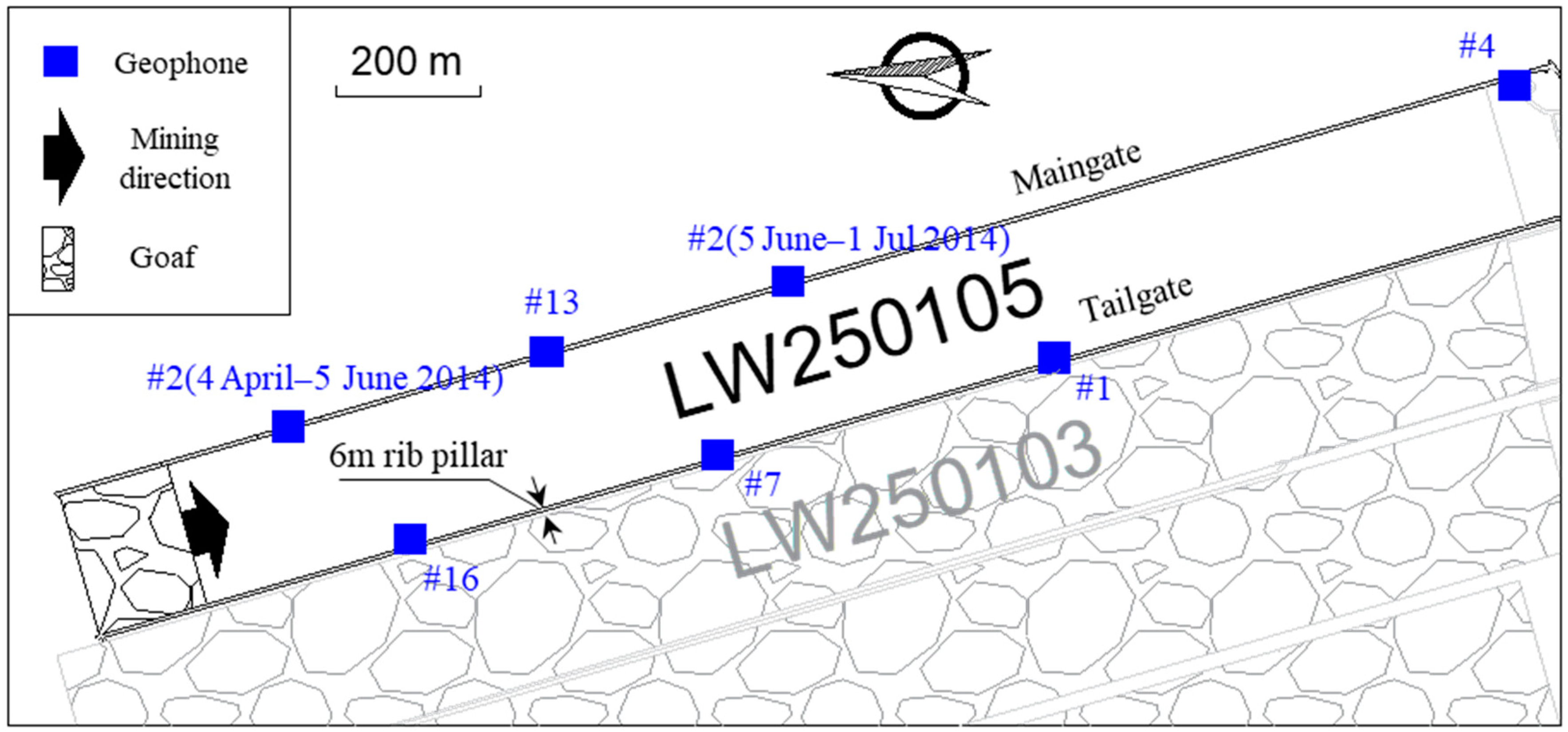
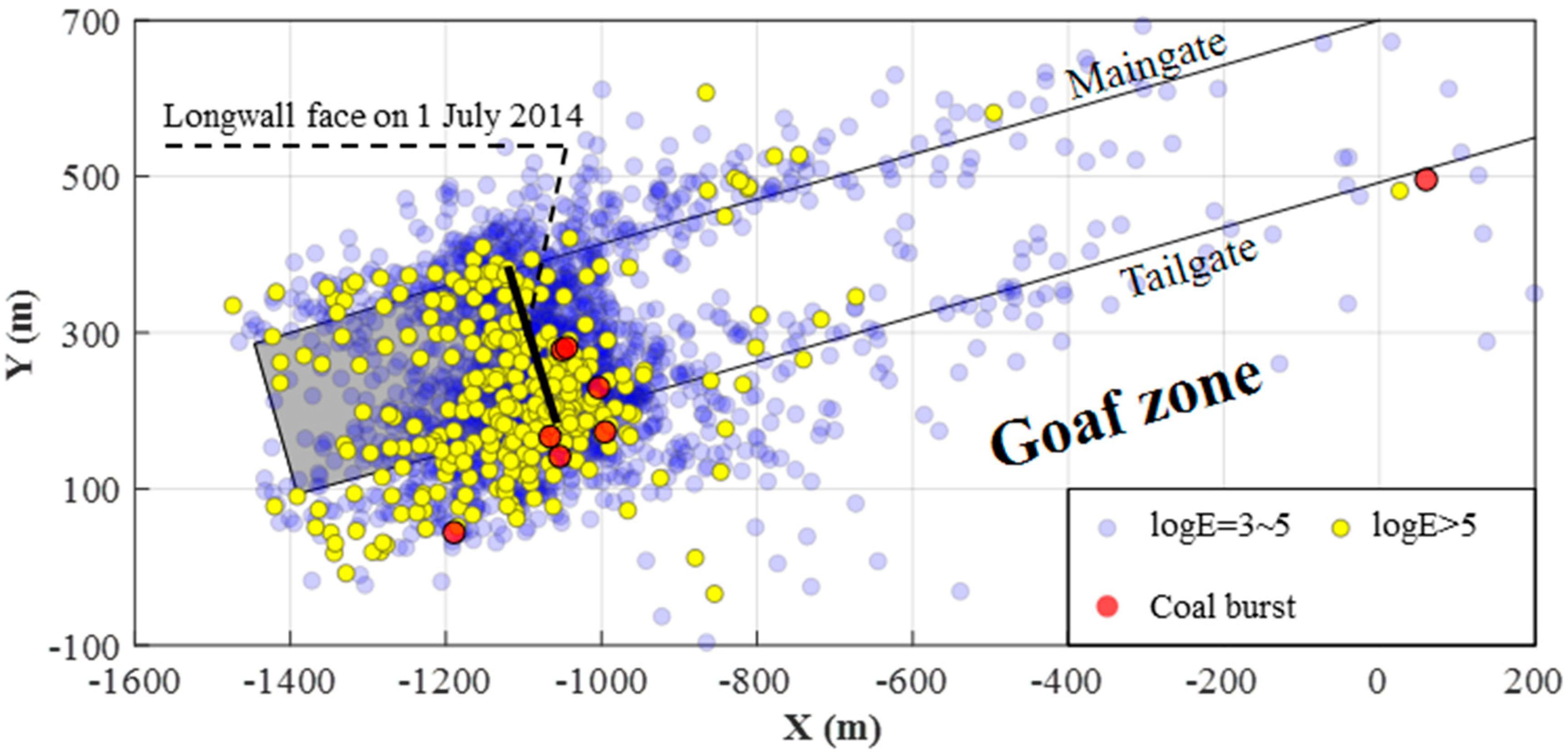
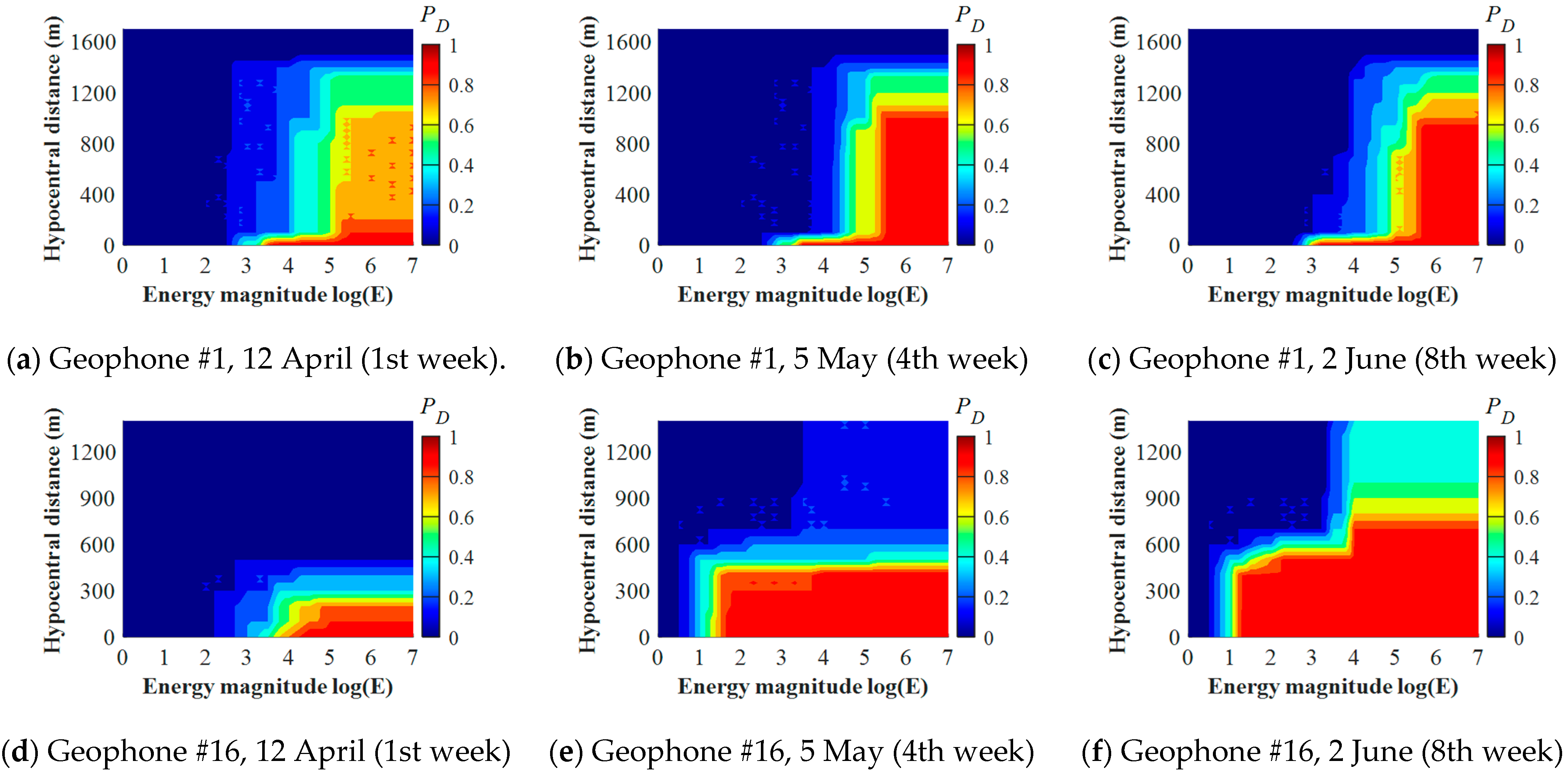
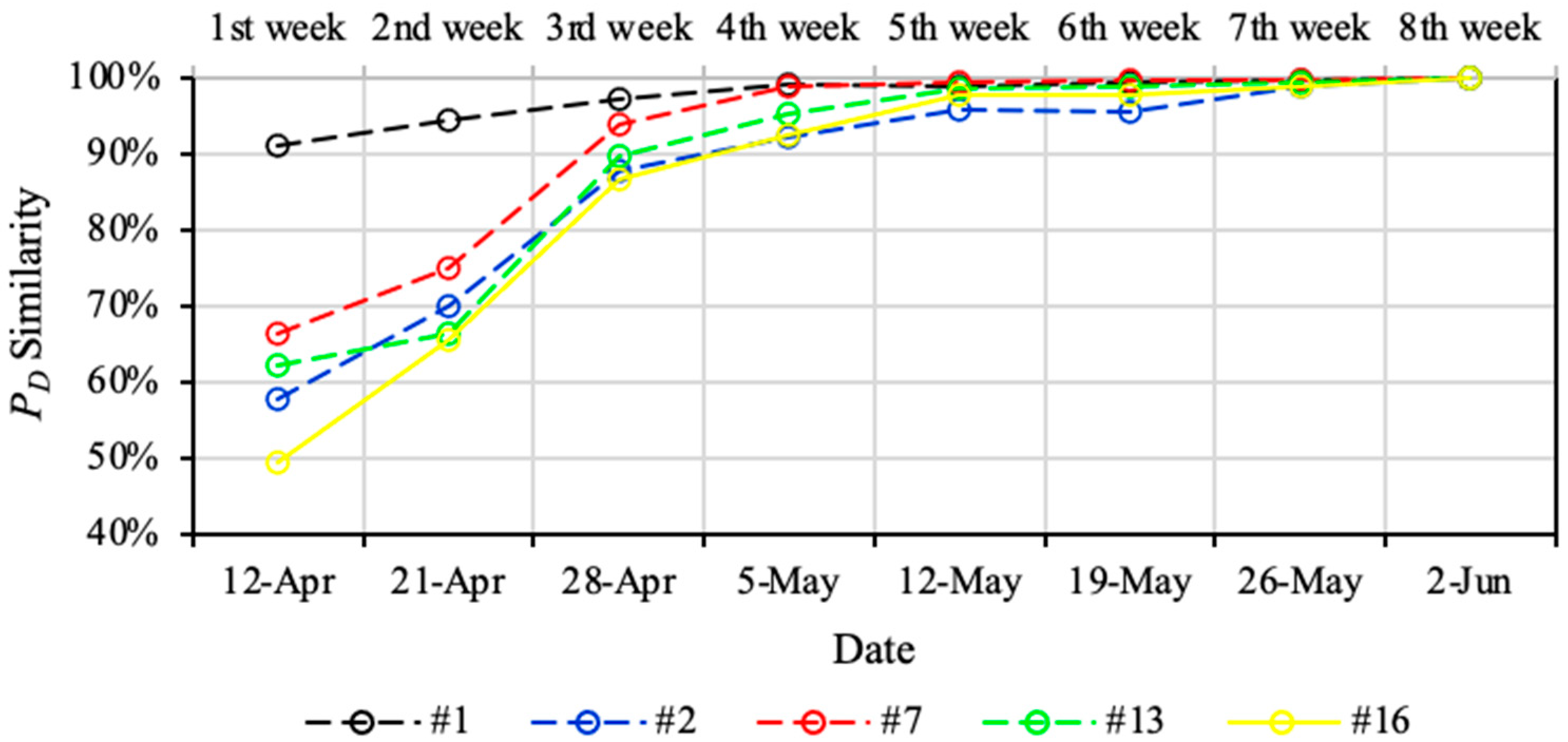
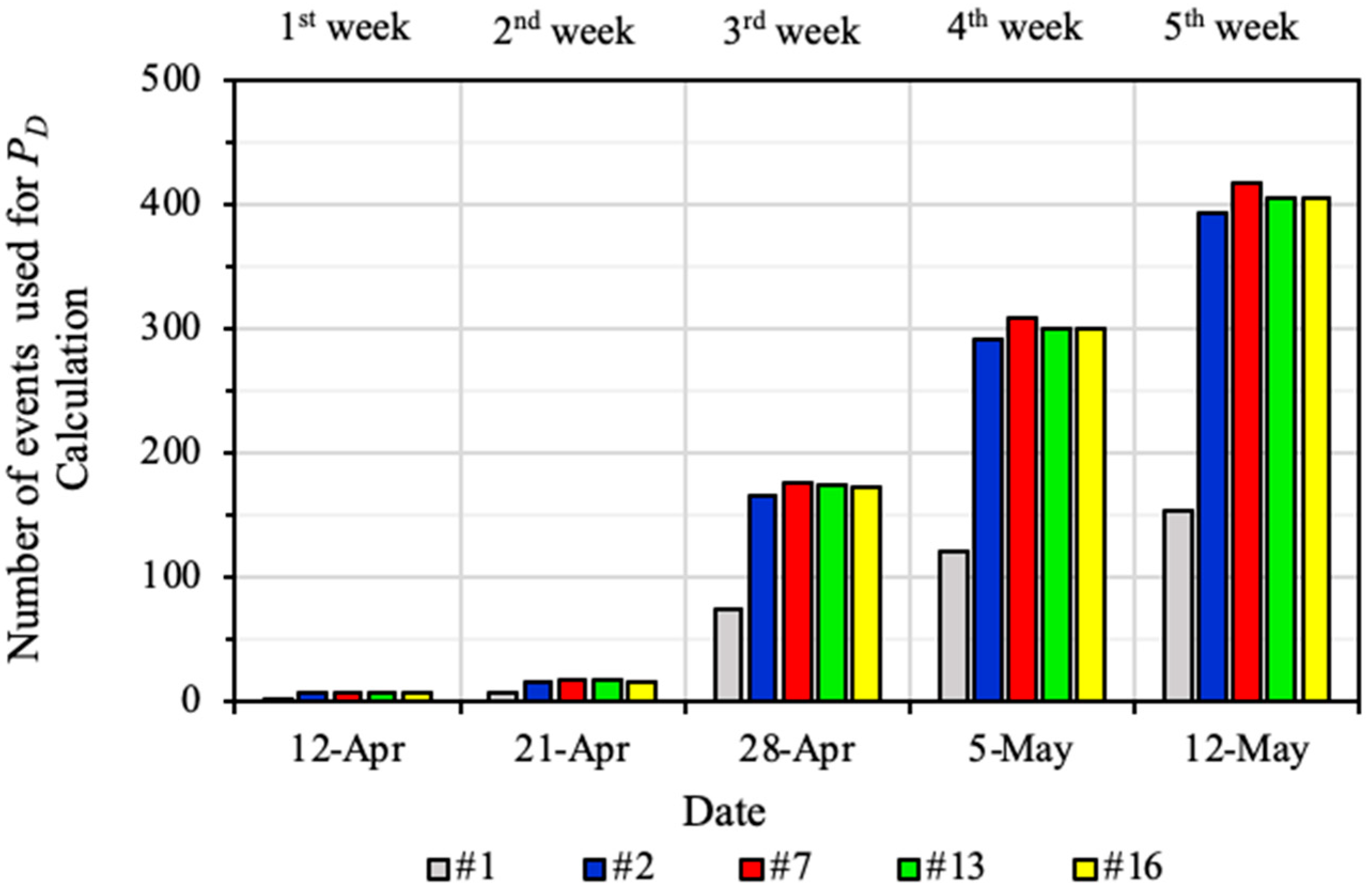

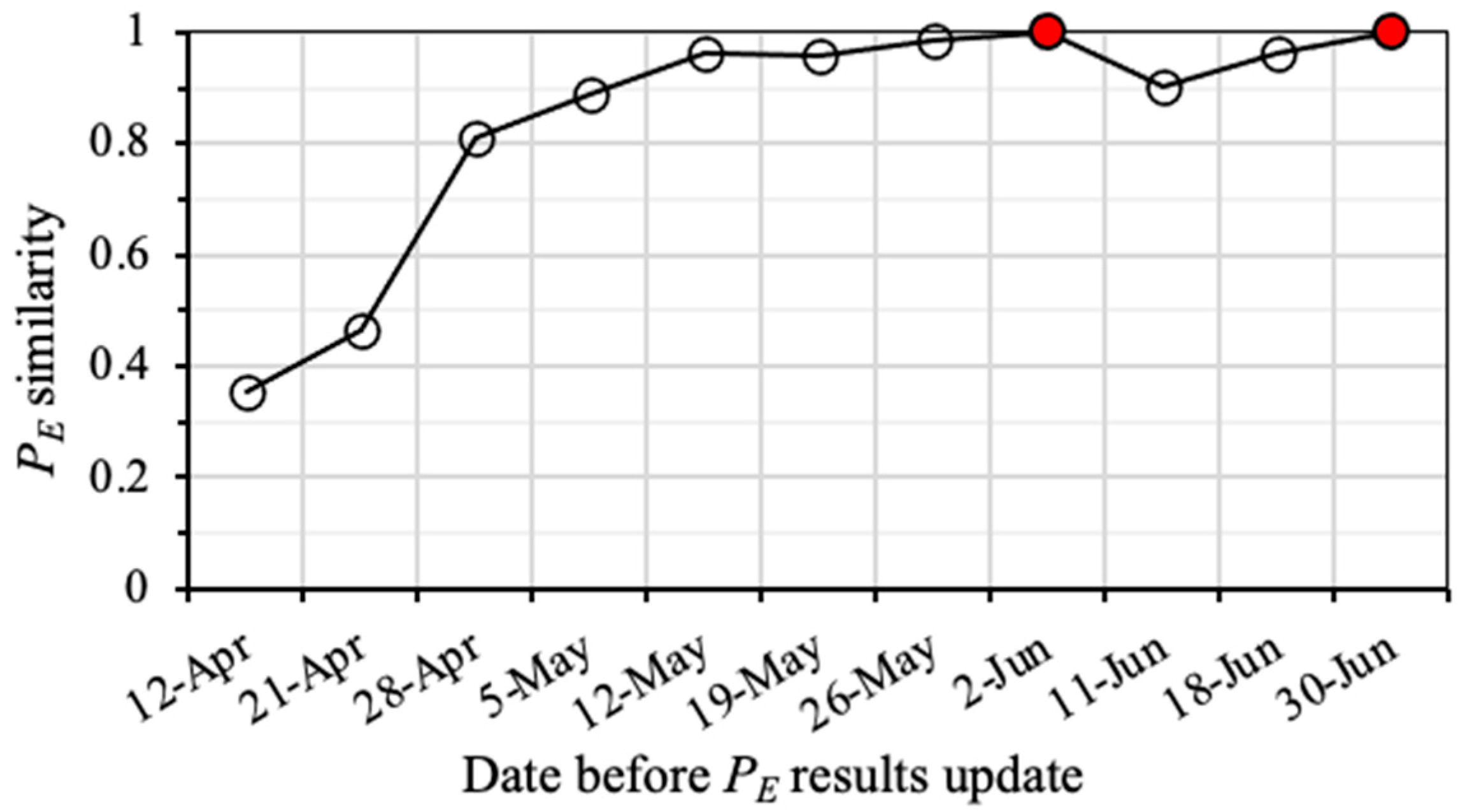
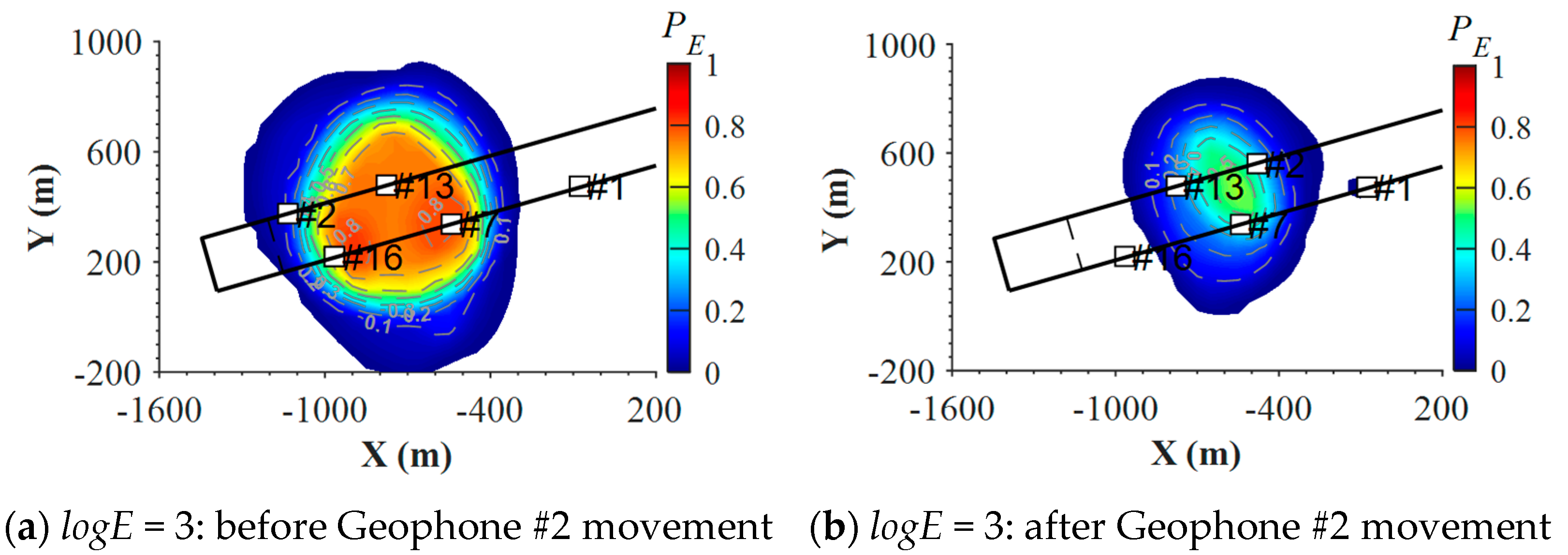


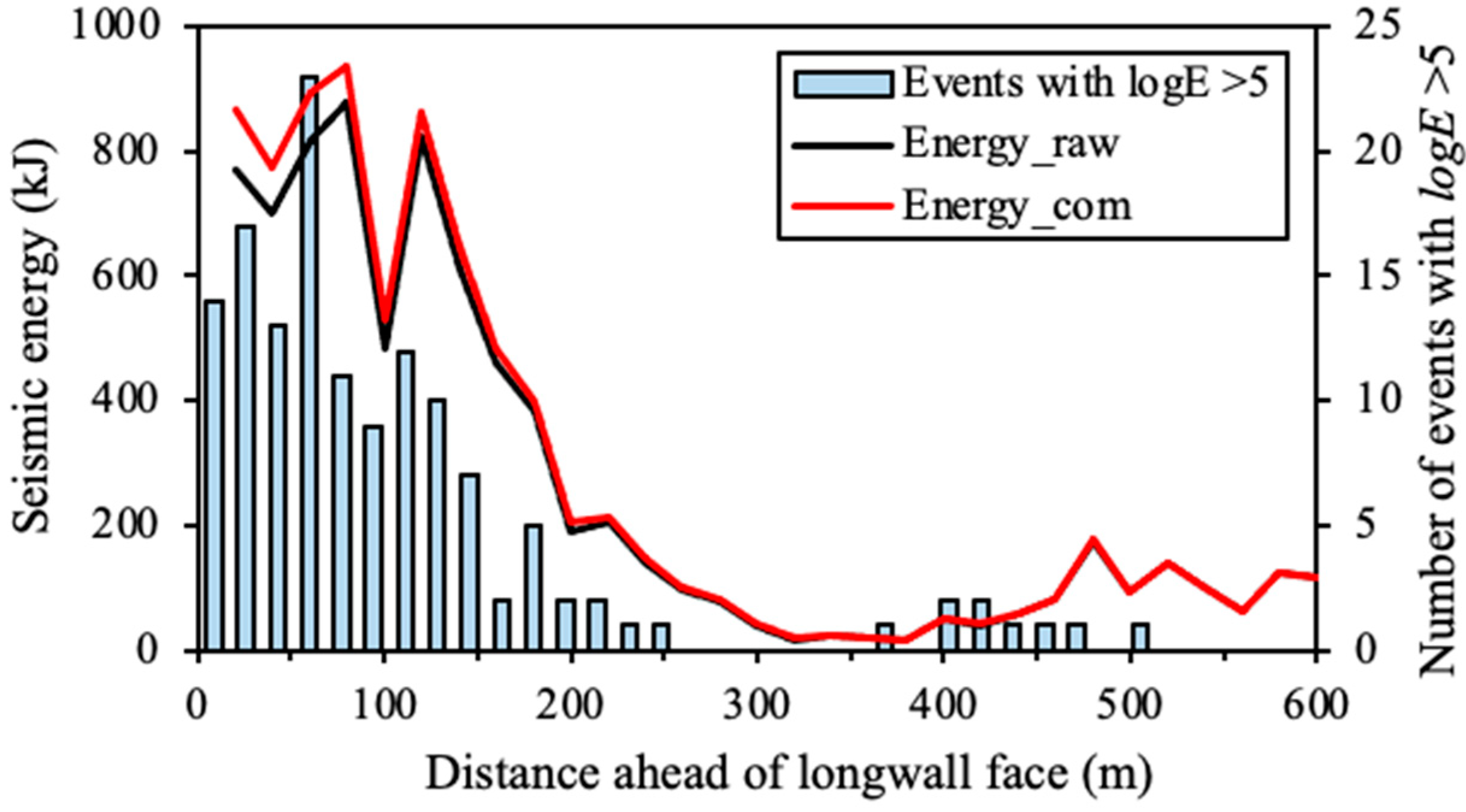

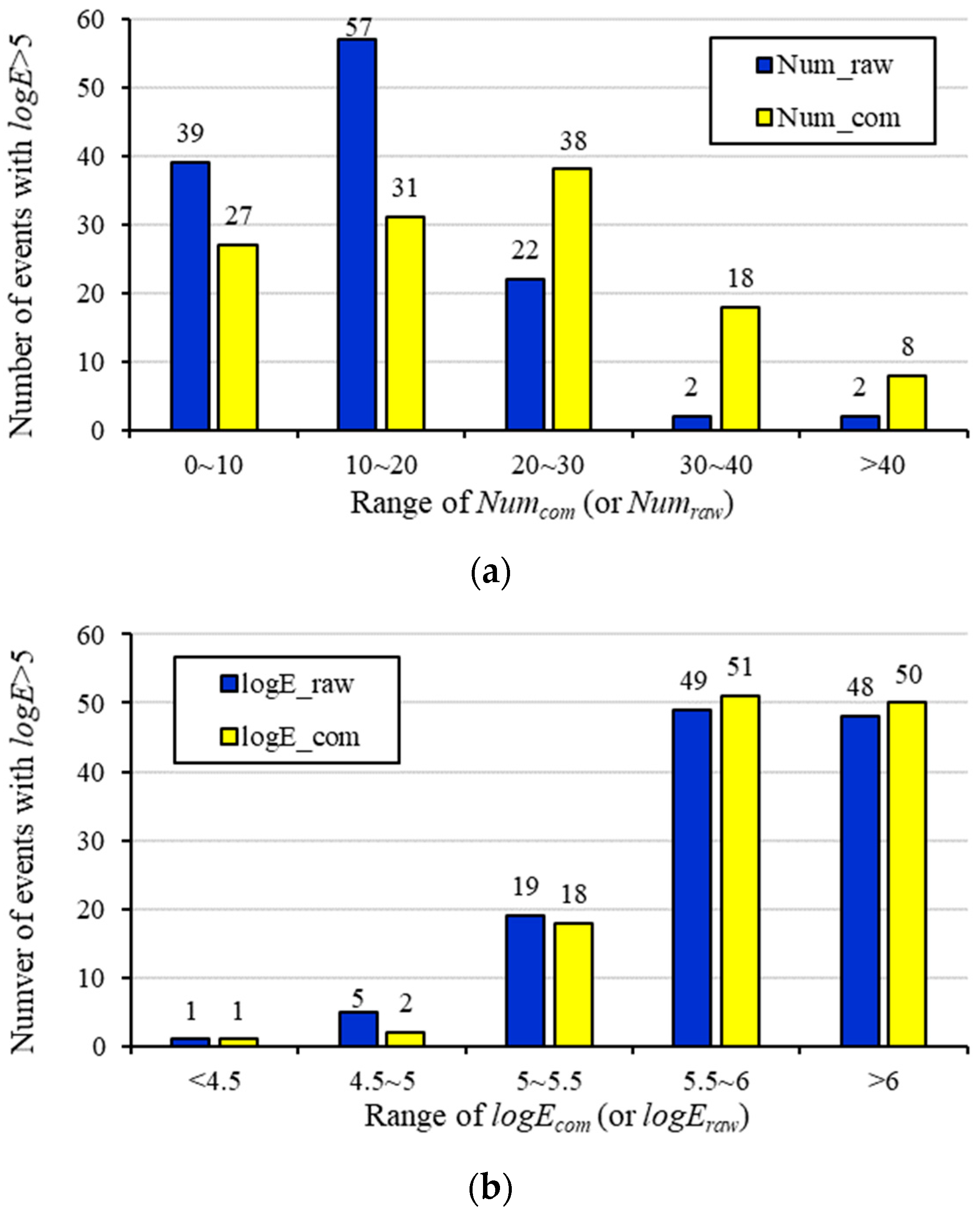
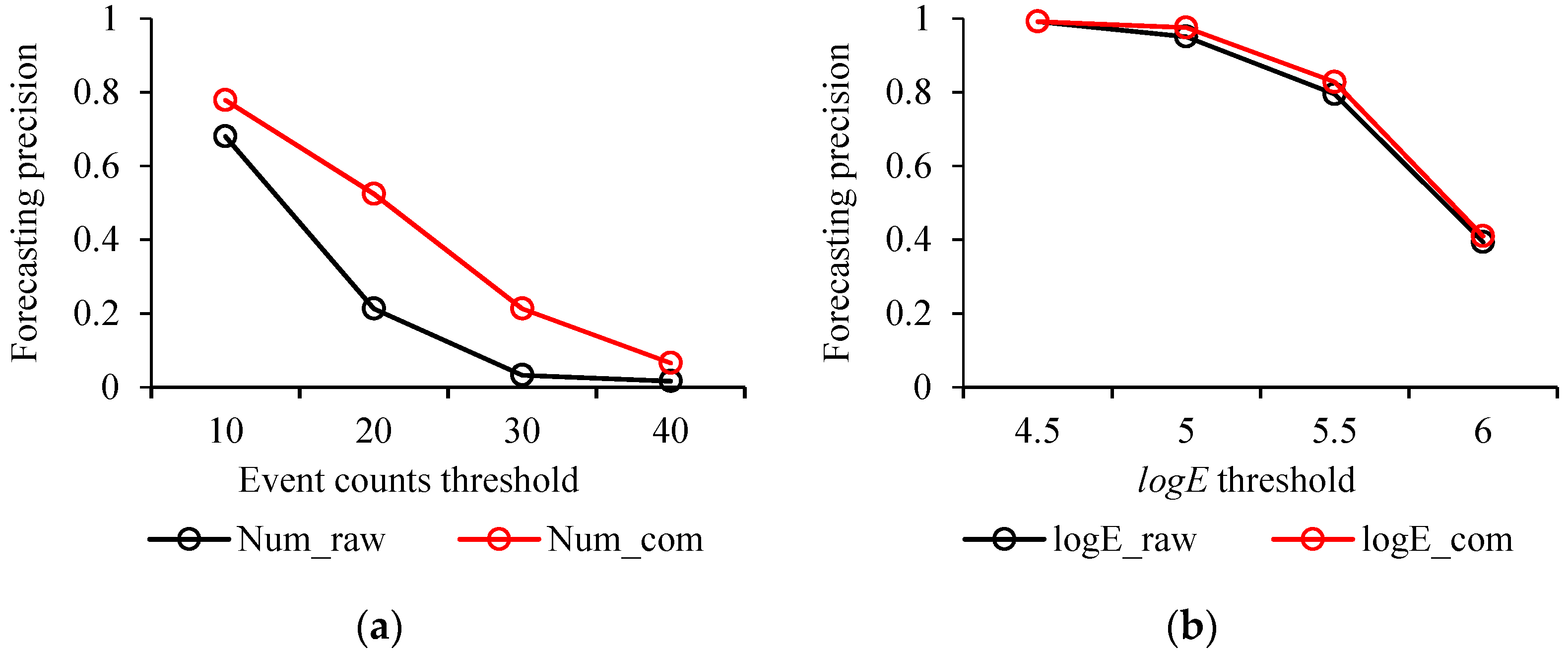

Publisher’s Note: MDPI stays neutral with regard to jurisdictional claims in published maps and institutional affiliations. |
© 2022 by the authors. Licensee MDPI, Basel, Switzerland. This article is an open access article distributed under the terms and conditions of the Creative Commons Attribution (CC BY) license (https://creativecommons.org/licenses/by/4.0/).
Share and Cite
Li, H.; Cao, A.; Gong, S.; Wang, C.; Zhang, R. Evolution Characteristics of Seismic Detection Probability in Underground Mines and Its Application for Assessing Seismic Risks—A Case Study. Sensors 2022, 22, 3682. https://doi.org/10.3390/s22103682
Li H, Cao A, Gong S, Wang C, Zhang R. Evolution Characteristics of Seismic Detection Probability in Underground Mines and Its Application for Assessing Seismic Risks—A Case Study. Sensors. 2022; 22(10):3682. https://doi.org/10.3390/s22103682
Chicago/Turabian StyleLi, Hui, Anye Cao, Siyuan Gong, Changbin Wang, and Rupei Zhang. 2022. "Evolution Characteristics of Seismic Detection Probability in Underground Mines and Its Application for Assessing Seismic Risks—A Case Study" Sensors 22, no. 10: 3682. https://doi.org/10.3390/s22103682
APA StyleLi, H., Cao, A., Gong, S., Wang, C., & Zhang, R. (2022). Evolution Characteristics of Seismic Detection Probability in Underground Mines and Its Application for Assessing Seismic Risks—A Case Study. Sensors, 22(10), 3682. https://doi.org/10.3390/s22103682




